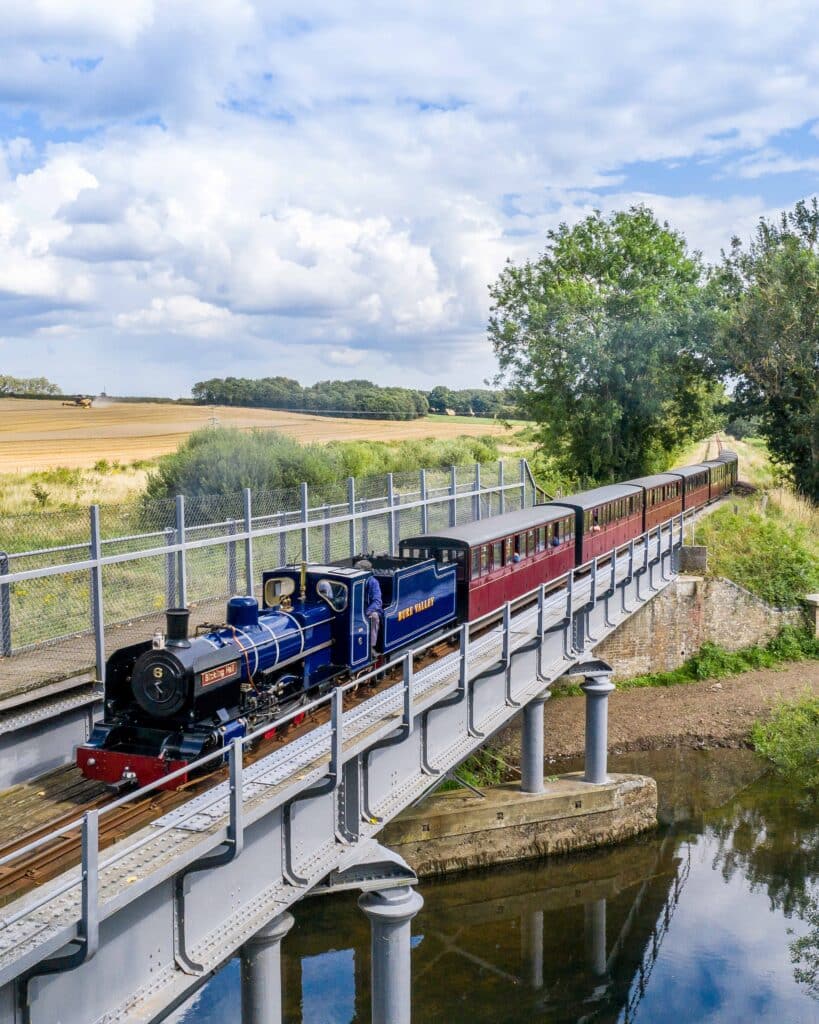Never has it been so important to find alternative fuel to power the UK’s steam locomotives. Coal is becoming increasingly difficult to source, with the only remaining mine in the UK producing lump coal (Ffos-Y-Fran near MerthyrTydfill) due to close this year.
Once stocks run out the industry will be reliant on foreign imports for its 26,000 tonnes of coal per year, accounting for 0.02 per cent of the UK’s carbon emissions. But this is more expensive and generates a huge carbon footprint, so survival depends on finding alternatives.
Leading the way is Norfolk’s longest narrow- gauge railway, a nine-mile line between the historic town of Aylsham and bustling town of Wroxham. For the past few years, Bure Valley Railway has been trialling bio-coals.
Environmental future
“Finding a sustainable steam coal is the biggest challenge facing the heritage railway movement and if we don’t sort out something we’re going to be in a very, very bad way,” said the railway’s managing director Andrew Barnes.
“We are already seeing the impact of dwindling coal supplies with Severn Valley and East Lancs scaling back some of their steam services to preserve coal supplies.
“As well as coal supplies running low, we also have to be conscious that the public might not want to travel on the trains in the future if they are not fuelled in a more environmentally friendly way.”
The railway has teamed up with Advanced Steam Traction Trust (ASTT), Heritage Railway Association (HRA), Network Rail, and the fuel manufacturer Coal Products Limited (CPL) to find an alternative, with trials well under way on comparing the burning of Welsh coal from Ffos-Y- Fran to variants of Ecoal50.
The latter comprises waste biomass from the olive oil production process, blended with coal dust, both of which would otherwise go to landfill, giving a 42 per cent reduction in CO2 emissions. Trials have taken place on the railway in June and November last year, and in March this year.
One size fits all would be best
Andrew added: “The ultimate aim is to get one product that will work across all railways, so either one good steam coal or bio-coal,” said Andrew. “If we’re unable to achieve that, what we want are formulas that work best for different railways.
“At the moment we’ve got products developed that would work for at least 50 per cent of the railways in the country. It’s not a one-size-fits-all yet, which is the ultimate nirvana of where we’d like to get to, but if we can carry on the work we’re doing, every success will increase that current 50 per cent.
“Beyond getting something that works for everybody what we really want to do is to get a total bio product that has got very limited coal content. We want to achieve this while maintaining the character, integrity, history and heritage of steam railways, but also recognising its environmental obligations.”
Although the tests carried out by Bure Valley initially were met with some scepticism as to the benefits for larger standard gauge railways, the trials are already making a difference, with the alternatives being tried on the Keighley and Worth Valley Railway earlier this year.
A unique formula
It was the first ever UK trial of bio-coal in a full size, standard gauge locomotive – the British Railways Standard ‘2MT’ 2-6-0 No. 78022. They pitted a trial batch of Homefire Ecoal, developed by CPL for use in steam locomotives, against the steeply graded, five-mile-long line in West Yorkshire.
In this trial CPL created a unique formula featuring up to 20 per cent biomass and manufactured using CPL’s hot cured process to provide greater strength and durability. The larger, specially shaped hexagonal ovoid was designed to sit on both narrow gauge and standard gauge locomotive firebars just like traditional coal and was classified as smokeless, emitting up to 80 per cent less particulate matter (smoke) than traditional coal.
“This was a significant milestone in the history of steam locomotives in the UK and it threw up a whole new load of data which we are now working with,” said Andrew.
“In March we held another two days of trials at Bure Valley researching both bio-coal and smokeless fuels that could be used. The next steps will be to look at the chemical analysis from the most recent trials and then to take some of the products we trialled on narrow gauge back to Keighley and Worth Valley Railway.
“We’ll keep doing that process of tweaking and trialling on the narrow gauge and then taking it to the standard gauge to see how it works.”
Collaboration has been at the heart of what Bure Valley is doing. Taking the lead, the railway is sharing the results with those interested and is on fortnightly video calls with half a dozen railways and scientists discussing how to take the work forward. Organisations trying other methods are also being urged to share their results.
Changing the industry
“We’re proud to be doing this and we are achieving results that the industry is taking on board,” said Andrew. “We’ve got to change as an industry, and we need the industry to be fully behind what we are doing and for us to work together on the solution.
“We’ve also been looking at some proprietary products and been trying them in a railway environment, which as a result has seen quite a few railways switching over to use some of these proprietary ovoids because they are struggling to get coal.
“The trial methodology has allowed that to happen, but parallel to that we’re continuing to trial bio-coal and we’re up to blend four now with CPL.
“It will be trialled at Keighley and Worth Valley Railway and then there will be detailed lab chemical analysis of the combustion and also the deposits, making sure they don’t adversely impact copper fire boxes, or if it’s a steel box you don’t want a chemical reaction between the combustion gases and the welds.”
As well as taking a pioneering role in trials of biomass blended fuel to replace traditional coal, Bure Valley has also adopted a raft of other initiatives in an effort to prove that steam railways can respond to ever increasing concerns about the environment.
Environmental innovation
Such has been the success, that the 15 inch gauge railway recently won the Heritage Railway Association Award for Environmental Innovation. It was also shortlisted in the Outstanding Visitor Attraction category.
“For the past few years we’ve been doing a lot of research on bio-coal, but also under my tenure of more than 20 years we’ve been looking at technical innovations on the locomotives,” said Andrew, who was delighted the railway was recognised for all its hard work.
“We’ve drawn inspiration from Formula One – they are always looking for improvements to performance through engine management systems and gas flow within the engines so we’ve looked at our steam locos, rigged up computers to them and looked at what’s degrading the efficiency of our steam locos.
“We actually took measurements of back pressure, smoke box vacuum, mechanical efficiency and said let’s measure this, quantify and document it and then design out the inefficiency. To look at the engine, you wouldn’t see any difference from before the improvements and after them – we’ve completed the work without degrading the efficiency of the actual underlying asset.”
Just some of the changes that have driven efficiencies includes making steam ways more smooth and without any angular passages and to smooth everything out internally, improving the blast nozzle, ensuring all the valve gears are perfectly balanced, putting needle roller bearings in instead of plain bearing, and making all the reciprocating mass properly balanced and weighted.
When it was proved on one locomotive to save a 30 per cent reduction in coal and water consumption, it was then rolled out across all of its five steam locos, a project which was completed early this year.
“As a result of this work we’ve saved 34 per cent of our coal consumption each year, but we’ve also increased the passenger train miles worked so it was actually a greater saving of around 79 tonnes of CO2 per year while running a greater number of train miles,” said Andrew, whose father worked for British Rail as a civil engineer and also worked on bridge design on the Ffestiniog Railway in North Wales.
“One thing we’ve also been doing is environmental audits of the railway, which includes things such as looking at recycling rubbish. All our lighting is now LED. It’s taken us probably 10 years to go over to entirely LED lighting, but we made the investment and that paid for itself in five years through savings of electricity consumption.
“We had gas removed from the site and no longer have mains gas coming in, so we’ve increased the use of electricity, but we’ve gone for energy-efficient appliances in our catering activities and we’ve shared that data back into the HRA.
“What we’re doing is looking at the railway on the whole, at where we are producing CO2 emissions that we can cut. We have to run the business as efficiently as possible but make them as environmentally friendly as possible as well.”
Bure Valley is one of more than 150 operational heritage railways in the UK, running trains over nearly 600 miles of track, with almost 500 stations. HRA stats say they provide 4,000 full-time equivalent jobs, supported by 22,000 volunteers, and pre-COVID welcomed more than 13 million visitors every year.
Fantastic achievements
Andrew, whose involvement with heritage railways started off with volunteering on the Ffestiniog, before joining Bure Valley, said: “It’s the best job in the world. I’m doing my dream job. “I won’t be here forever. What I’ve got to do is work with the HRA to make sure the industry is sustainable and viable, both financially and environmentally for the long-term future.
“What we’ve done overall as heritage railways is fantastic. When we started 60 years ago the railway industry didn’t think it was possible and just thought it was groups of people playing trains.
“What has been achieved over that time has been fantastic, but from then when the focus was on saving lines, rolling stock, locomotives and restoring them, now the industry is more mature and is beginning to acknowledge its environmental obligations and its environmental responsibilities, and I think we are very well placed to combine that with its educational and heritage obligations.
“We’re preserving heritage and history but actually doing it in a way that’s as environmentally friendly and responsible as possible.”





